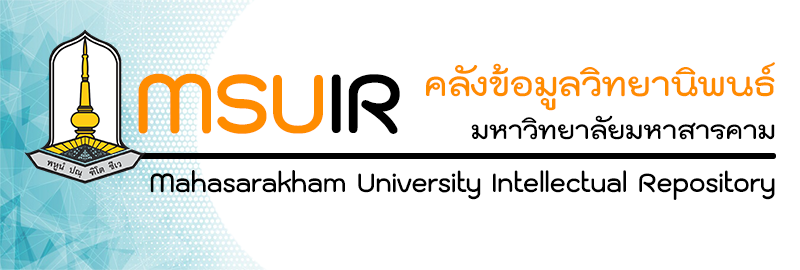Please use this identifier to cite or link to this item:
http://202.28.34.124/dspace/handle123456789/2874Full metadata record
| DC Field | Value | Language |
|---|---|---|
| dc.contributor | Wilairat Suwannasom | en |
| dc.contributor | วิไลรัตน์ สุวรรณสม | th |
| dc.contributor.advisor | Suwat Junsuwan | en |
| dc.contributor.advisor | สุวัฒน์ จุลสุวรรณ์ | th |
| dc.contributor.other | Mahasarakham University | en |
| dc.date.accessioned | 2025-05-07T11:40:10Z | - |
| dc.date.available | 2025-05-07T11:40:10Z | - |
| dc.date.created | 2024 | |
| dc.date.issued | 19/2/2024 | |
| dc.identifier.uri | http://202.28.34.124/dspace/handle123456789/2874 | - |
| dc.description.abstract | The aim of this research were 1) to study the current situation, desirable conditions, and the needs assessment for internal quality assurance, and 2) to develop guidelines for internal quality assurance by a participatory management within the schools affiliated with the Secondary Education Service Area Office in Maha Sarakham. The research was structured into 2 phases. The first phase was to study of the current situation, desirable conditions and the needs assessment for internal quality assurance involves collecting data from the questionnaire and a sample group of 317 individuals, including school administrators and teachers. The sample size was determined using Krejcie and Morgan's table, and stratified random sampling technique was employed. The second phase was to develop guidelines of internal quality assurance by a participatory management. This phase included interviews with school administrators and quality assurance department heads from the schools with best practice, along with data collection from five qualified individuals. Statistical methods was employed in the research comprise mean, standard deviation, and modified priority needs Index. The research findings indicated that: 1. The current status of internal quality assurance was generally found to be at a moderate level, with overall conditions being deemed desirable and ranking at the highest level. The analysis of the priority needs index for internal quality assurance was arranged in descending order, with the following priorities: The evaluation and verification of the quality of education within schools. The continuous improvement in the quality of education. The establishment of educational standards for schools. The formulation of educational development plans for schools. The creation of self-assessment reports. The implementation of educational development plans for schools. The monitoring of operational results to develop the school's quality according to the standards of school. 2. Development of guidelines for internal quality assurance by a participatory management was deemed highly suitable and feasible overall. The guidelines for internal quality assurance involved the participation of school administrators, teachers, educational staff and the basic school committee in planning, executing, benefiting and participating in monitoring and evaluation. The guidelines for internal quality assurance by a participatory management, consisting of 7 components and 41 strategies: 1. Establishing educational standards for the school - 7 strategies. 2. Creating educational development plan for the school - 6 strategies. 3. Implementing according to educational development plan for the school - 6 strategies. 4. Evaluating and verifying the quality of education within the school - 6 strategies. 5. Monitoring the results of operations to develop the school's quality according to the standards of school - 5 strategies. 6. Creating self-assessment reports - 7 strategies. 7. Continuous improvement in the quality of education - 4 strategies. | en |
| dc.description.abstract | การวิจัยครั้งนี้มีจุดประสงค์เพื่อ 1) ศึกษาสภาพปัจจุบัน สภาพที่พึงประสงค์ และความต้องการจำเป็นของการดำเนินงานประกันคุณภาพการศึกษาภายในสถานศึกษา ของสถานศึกษาสังกัดสำนักงานเขตพื้นที่การศึกษามัธยมศึกษามหาสารคาม 2) พัฒนาแนวทางการดำเนินงานประกันคุณภาพการศึกษาภายในสถานศึกษา โดยใช้การบริหารแบบมีส่วนร่วม ของสถานศึกษาสังกัดสำนักงานเขตพื้นที่การศึกษามัธยมศึกษามหาสารคาม การวิจัยแบ่งออกเป็น 2 ระยะ ดังนี้ ระยะที่ 1 การศึกษาสภาพปัจจุบัน สภาพที่พึงประสงค์ และความต้องการจำเป็นของการดำเนินงานการประกันคุณภาพการศึกษาภายในสถานศึกษา โดยใช้แบบสอบถามในการเก็บรวบรวมข้อมูล และกลุ่มตัวอย่าง ประกอบด้วย ผู้บริหารสถานศึกษาและครูผู้สอน จำนวน 317 คน โดยใช้ตารางกำหนดขนาดกลุ่มตัวอย่างของ Krejcie และ Morgan ใช้เทคนิคการสุ่มแบบแบ่งชั้น ระยะที่ 2 การพัฒนาแนวทางการดำเนินงานประกันคุณภาพการศึกษาภายในสถานศึกษา โดยใช้การบริหารแบบมีส่วนร่วม โดยใช้แบบสัมภาษณ์ผู้บริหารสถานศึกษาและหัวหน้างานประกันคุณภาพของโรงเรียนที่มีวิธีปฏิบัติที่ดี และแบบประเมินในการรวบรวมข้อมูลจากผู้ทรงคุณวุฒิจำนวน 5 คน สถิติที่ใช้ในการวิจัย คือ ค่าเฉลี่ย ส่วนเบี่ยงเบนมาตรฐาน และการวิเคราะห์ค่าดัชนีความต้องการจำเป็น ผลการวิจัยพบว่า 1. สภาพปัจจุบันของการดำเนินงานประกันคุณภาพการศึกษาภายในสถานศึกษาของสถานศึกษาสังกัดสำนักงานเขตพื้นที่การศึกษามัธยมศึกษามหาสารคาม โดยรวมอยู่ในระดับปานกลาง และมีสภาพที่พึงประสงค์ โดยรวมอยู่ในระดับมากที่สุด และความต้องการจำเป็นของการดำเนินงานประกันคุณภาพการศึกษาภายในสถานศึกษา เรียงลำดับจากมากไปหาน้อย คือ การประเมินผลและตรวจสอบคุณภาพการศึกษาภายในสถานศึกษา การกำหนดมาตรฐานการศึกษาของสถานศึกษา การพัฒนาคุณภาพการศึกษาอย่างต่อเนื่อง การจัดทำแผนพัฒนาการจัดการศึกษาของสถานศึกษา การจัดทำรายงานผลการประเมินตนเอง การดำเนินการตามแผนพัฒนาการจัดการศึกษาของสถานศึกษา การติดตามผลการดำเนินการเพื่อพัฒนาสถานศึกษาให้มีคุณภาพตามมาตรฐานของสถานศึกษา 2. การพัฒนาแนวทางการดำเนินงานประกันคุณภาพการศึกษาภายในสถานศึกษา โดยใช้การบริหารแบบมีส่วนร่วม ของสถานศึกษาสังกัดสำนักงานเขตพื้นที่การศึกษามัธยมศึกษามหาสารคาม มีความเหมาะสมและความเป็นไปได้โดยรวมอยู่ในระดับมากที่สุด และเป็นแนวทางการดำเนินงานประกันคุณภาพการศึกษาภายในสถานศึกษาที่ผู้บริหาร ครูและบุคลากรทางการศึกษา และคณะกรรมการสถานศึกษาขั้นพื้นฐาน มีส่วนร่วมในการวางแผน มีส่วนร่วมในการดำเนินการ มีส่วนร่วมในผลประโยชน์ และมีส่วนร่วมในการติดตามและประเมินผล และได้แนวทางการดำเนินงานประกันคุณภาพการศึกษาภายในสถานศึกษา โดยใช้การบริหารแบบมีส่วนร่วม 7 องค์ประกอบ 41 แนวทาง ดังนี้ 1. การกำหนดมาตรฐานการศึกษาของสถานศึกษา จำนวน 7 แนวทาง 2. การจัดทำแผนพัฒนาการจัดการศึกษาของสถานศึกษา จำนวน 6 แนวทาง 3. การดำเนินการตามแผนพัฒนาการจัดการศึกษาของสถานศึกษา จำนวน 6 แนวทาง 4. การประเมินผลและตรวจสอบคุณภาพการศึกษาภายในสถานศึกษา จำนวน 6 แนวทาง 5. การติดตามผลการดำเนินการเพื่อพัฒนาสถานศึกษาให้มีคุณภาพตามมาตรฐานของสถานศึกษา จำนวน 5 แนวทาง 6. การจัดทำรายงานผลการประเมินตนเอง จำนวน 7 แนวทาง 7. การพัฒนาคุณภาพการศึกษาอย่างต่อเนื่อง จำนวน 4 แนวทาง | th |
| dc.language.iso | th | |
| dc.publisher | Mahasarakham University | |
| dc.rights | Mahasarakham University | |
| dc.subject | การพัฒนาแนวทาง | th |
| dc.subject | การประกันคุณภาพการศึกษาภายในสถานศึกษา | th |
| dc.subject | การบริหารแบบมีส่วนร่วม | th |
| dc.subject | Development of Guidelines | en |
| dc.subject | Internal Quality Assurance | en |
| dc.subject | Participatory Management | en |
| dc.subject.classification | Social Sciences | en |
| dc.subject.classification | Education | en |
| dc.subject.classification | Education science | en |
| dc.title | Developing Guidelines for Internal Quality Assurance by a Participatory Management within the Schools Affiliated with the Secondary Education Service Area Office in Maha Sarakham | en |
| dc.title | การพัฒนาแนวทางการดำเนินงานประกันคุณภาพการศึกษาภายในสถานศึกษา โดยใช้การบริหารแบบมีส่วนร่วม ของสถานศึกษาสังกัดสำนักงานเขตพื้นที่ การศึกษามัธยมศึกษามหาสารคาม | th |
| dc.type | Thesis | en |
| dc.type | วิทยานิพนธ์ | th |
| dc.contributor.coadvisor | Suwat Junsuwan | en |
| dc.contributor.coadvisor | สุวัฒน์ จุลสุวรรณ์ | th |
| dc.contributor.emailadvisor | suwat.j@msu.ac.th | |
| dc.contributor.emailcoadvisor | suwat.j@msu.ac.th | |
| dc.description.degreename | Master of Education (M.Ed.) | en |
| dc.description.degreename | การศึกษามหาบัณฑิต (กศ.ม.) | th |
| dc.description.degreelevel | Master's Degree | en |
| dc.description.degreelevel | ปริญญาโท | th |
| dc.description.degreediscipline | Educational Administration | en |
| dc.description.degreediscipline | ภาควิชาการบริหารการศึกษา | th |
| Appears in Collections: | The Faculty of Education | |
Files in This Item:
| File | Description | Size | Format | |
|---|---|---|---|---|
| 65010581054.pdf | 10.67 MB | Adobe PDF | View/Open |
Items in DSpace are protected by copyright, with all rights reserved, unless otherwise indicated.

